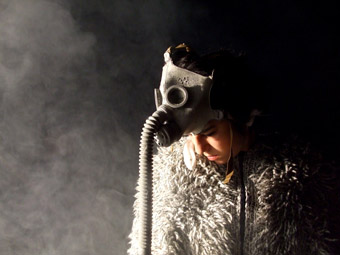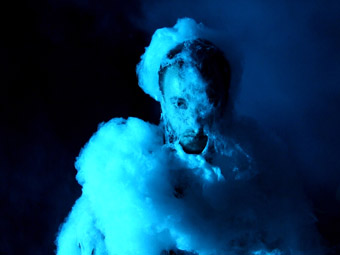unexpected treats
rosie dennis at the plateaux festival in frankfurt

Comeback
courtesy Monster Truck
Comeback
OPENING NIGHT OF THE PLATEAUX FESTIVAL SAW THE FOYER FILLED WITH PEOPLE EATING TRI-COLOURED ICE-BLOCKS COVERED WITH SOMETHING THAT UNEXPECTEDLY CRACKLED AND POPPED IN YOUR MOUTH. IT WAS A GOOD METAPHOR FOR WHAT WAS TO COME OVER THE NEXT TWO WEEKS. THE INTERNATIONAL FESTIVAL TAKES PLACE ANNUALLY AT THE MOUSONTURM KÜNSTLERHAUS IN FRANKFURT, GERMANY, FOCUSING ON NEW DIRECTIONS IN CONTEMPORARY PERFORMANCE WHETHER IN THEATRE, DANCE, SOUND OR VIDEO. EIGHT YEARS ON, IT’S BUILDING A REPUTATION AMONGST ARTISTS AND PRESENTERS AS A PLATFORM FOR EXCITING, AMBITIOUS AND PROVOCATIVE WORK.
Comeback, a sugar-coated fairytale from the young German company Monster Truck opened the festival. It is a nightmarish theatrical spectacle that has overtones of Forced Entertainment’s Bloody Mess and, from Australia, My Darling Patricia’s Politely Savage. Comeback explores the things we are afraid of—mostly from childhood—and is realised as a fantastical nightmare featuring a candy dome-shaped house, a wolf in sheep’s clothing, a depressed donkey and libido-crazed wardrobe. It has very little dialogue, instead popular music shapes the non-linear narrative: AC/DC’s Thunderstruck when a heavy storm of candy floss blows in; Fancy Pants for the horny cupboard; and Ground Control to Major Tom to accompanies the precarious journey of a tin of beans travelling into the dark of night.
All of this might seem clichéd and obvious but the Monster Truckers are skilled makers, storytellers and performers. The entire set is handmade and remade for each performance by the five artists. Sugar and water boil for hours to make toffee windows that are re-installed in the house each day only to be smashed with an ice-pick in the evening; a candy floss machine is restocked with kilos of sugar for a snow sugar blizzard which leaves a deliciously sweet smell in the air; the roof of the house is rebuilt and re-covered in metres and metres of aluminium foil.

Comeback
courtesy Monster Truck
Comeback
My delight with Comeback was in the level of detail realised in each of the dreamlike images, the raw and recycled aesthetic of the set and costumes, and the surprising dramaturgical choices made to realise this fantastical tale. Leaving the theatre it felt like I had visited a surreal playground. I was giddy on the pandemonium, delighting in the chaos of night.
Throughout the festival the work of filmmaker Björn Renner played on a continuous loop across three screens in the foyer. Shot on 16mm the films ranged from a pop-music video clip (The Knife) to a claustrophobic afternoon tea with a fractured mother and her two grown, (co-)dependent sons (Exquisite Moments). Renner’s films are visually rich pastiches of child-like illustration, collage and animation spliced with film.
The main theme of the films’ emotionally disturbing content is dysfunctional relationships, whether with self, mother, teacher or partner. Each frame in Renner’s films appears like a blank canvas which the artist fills with absurd, surreal, sublime and ultimately compelling images. His films reminded me of a textured scrapbook—cluttered and overloaded with cut-outs, ideas and cultural references that were, at times, homoerotic and Freudian and, at others, innocent and naïve.
I was particularly drawn to the use of sound in Renner’s films. Composers Robin Spurrier and Michael Hansson use a diverse and heavily textured palette that ranges from the enchanted beauty of the harp to an extreme mash-up of noise. There was a seamless integration between sound and image that added to the unsettling experience for the audience.
Requiem is the latest show from the Swiss experimental sound group Velma. For this new work they transformed the large theatre at Mousonturm into a 1970s analogue sound recording studio complete with tan lo-pile carpet, a wood-panelled soundproof room (which doubled as a surface for projection) and moveable soundproofing boards. The audience sat inside the studio with the musicians watching the ‘session’ which included a manic drum solo, whispered a capella singing and a ‘melody’ played on a muted Casio keyboard.
The first half of the show was engaging and quite funny (even though the German audience wasn’t laughing) as the performers ‘set up’ for the gig. The non-performing bordered slightly on ‘acting’, however not enough to appear contrived, and the theatricality deployed in presenting experimental sound was exciting and visually superb. I could have watched the drummer all night: he looked like he had walked straight off the set of a Blaxploitation flick while one of the women in the group was a dead-ringer for Charlotte Gainsbourg. For a good 30 minutes I was happily taken for the ride. The group stuck strictly to Vatican rules about the duration of a requiem, making the show a little too long, and a little flat in the second half, too restrained and, at times, predictable and clichéd—especially in the way women were portrayed. The men played instruments and dictated the rhythm and flow of the show while the women had a sexual revolution, rubbing butter on glass and making love to a chair.
In a much more intimate show, Phantomgeschichte, using a screen and a miniature stage, Nicola Unger from the Netherlands tells the true story of her landlady “who charges too much rent for her flat in Rotterdam” and whose life changed forever one night in 1975 when she attended the same party as the most wanted man in the world, a terrorist, The Jackal.
Unger’s performance is quiet and considered. She sits in close proximity to the audience with her collection of cardboard cut-outs making the experience very personal. Using shadows, projection and simple animation, she tells the story of this night. She sets the stage, literally, for the events that are to follow, introducing the characters one at a time: “You will be a stewardess, and have three children and one of them will be disabled. You will work for Interpol. You will be the underdog. You will take fingerprints. You will check passports.”
Scenes change with the click of a finger as Unger slides people, palm trees and motorbikes across her miniature stage on long sticks. It’s easy to lose yourself moving between the one-dimensional world of cardboard cut-outs and projected images—each telling the same story in a very different way. This aesthetic contrast worked well although I preferred the miniature stage where I could watch Unger concentrating, preparing for the next character’s entrance.
As the story of the night unfolds, the focus shifts to the present day and becomes a comment on the war on terror with Osama Bin Laden taking the place of The Jackal. In the closing stages of the show, Unger highlights the media’s ongoing obsession with ‘a really good story’ whether then or now. As the show’s title suggests, this is a story that never dies.
Plateaux Festival: Monster Truck, Comeback, creators Manuel Gerst, Matthias Meppelink, Boris Nikitin, Sahar Rahimi, Cecilie Ullerup Schmidt, Ina Vera; Björn Renner Films, director Björn Renner, co-director Christoffer Paues, sound Robin Spurrier, Michael Hansson; Velma, Requiem, creators Christian Garcia, Christophe Jaquet, Valerie Liengme, Arantxa Martinez, Stephane Vecchione, music velma, lighting design Laurent Junod, sound design Ludovic Gugliemazzi, costumes Tania D’Ambrogio, scenography Serge Perret, production & dramaturgy Anja Haelg; Phantomgeschichte, concept, performer Nicola Unger, narrator Duro Toomato, sound Jonathan F Brown; Moustonturm Künstlerhaus, Frankfurt, April 17–26
RealTime issue #85 June-July 2008 pg. 8






